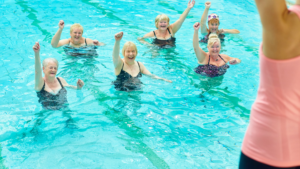Pain affects every aspect of your life, and normal daily activities are challenging when living with chronic pain. From the amount of sleep you get to the thoughts you have, pain can negatively affect your quality of life.
Your day-to-day activities are crucial in managing your pain and maintaining a healthier life. Positive changes to your routine and lifestyle are excellent ways to reduce pain and improve your mood.
Simple changes and additions to your daily life can make managing your pain easy.

Learn how to Manage Chronic Pain at Home
How to Manage Chronic Pain at Home
Deep Breathing or Meditation
Practicing relaxation skills such as breathing exercises, visual imagery, meditation, and mindfulness are some techniques that can help you center yourself and take your focus off the pain you experience.
Reducing Stress
Stress and Pain go hand-in-hand. When you are stressed, your body may react in different ways – such as tensing muscles – which can increase your pain. This can be prevented by reducing and managing your stress.
Stress can have a negative impact on your relationships, work ethic, eating habits, and mood. Keep a list of what stresses you out and consider how it affects your life. Once you have a list of stressors, think of ways you can minimize them or eliminate the triggers. For example, if you get stressed and feel rushed during the work week, brainstorm ways you can make the week easier by incorporating things like meal prep, picking out your outfit the night before, or other ways to make the week go more smoothly.
Stay Active
If you struggle from pain, exercise may provide the relief you are looking for. Cardio exercises use large muscle groups and raise your heartrate, which releases endorphins – you body’s natural painkillers. Exercising for 30-45 minutes of low-intensity aerobic exercise is recommended and can help relieve pain.
Talking with your doctor before starting any new exercise program is important.
Get More Sleep
It is no secret that pain can interfere with a good night’s sleep. You may have issues falling asleep or staying asleep throughout the night. Medications can cause sleep issues, too. If your pain medication causes drowsiness and fatigue, you may be more inclined to sleep during the day instead of at night. Getting a proper amount of sleep at night is important to how your body copes with pain and how your body boosts your energy levels.
Here are some ways to sleep better:
- Practice Relaxation: Write in a journal, listen to soothing music, or practice deep breathing techniques to help prepare your body for restful sleep.
- Set a Schedule: Routine sleeping can help you get better sleep. Go to bed at the same time and set an alarm for the same time each day.
- Be Mindful of What You Eat and Drink: Caffeine and alcohol can affect sleep patterns, as well as heavy meals. If you need a snack before bed, try almond butter on toast, crackers and cheese, or nuts and fruit.
Managing your pain at home is achievable when you have the support of a comprehensive care physician. Get the help you need from the team at Progressive Pain Management by filling out the form below.
Anyone with stiff joints or chronic pain knows how relaxing it can be to slip into a warm bath at the end of the day. This is because the water pressure alleviates the pressure you place on your joints. There is a lot of science behind this buoyant force, and it is the same reason why you feel weightless in water.
When you live with chronic pain, you know that any relief is welcomed. Many pain specialists and physical therapists recommend water therapy for patients with fibromyalgia, osteoarthritis, or chronic joint pain. This does not always mean participating in group water aerobics. Aquatic therapy can also include floating therapy and water yoga.

Aquatic Therapy to Help Reduce Pain
How Aquatic Therapy Helps Ease Chronic Pain
- Water Aerobics for Osteoarthritis
People with osteoporosis benefit greatly from doing water exercises. This allows their muscles to stretch and strengthen using the gentle resistance of water. Stretches like lifting your knees to your chest and using the side of the pool to do leg lifts and arm stretches are good for your muscles and improve your range of motion.
Water aerobics are another type of therapy that prove beneficial for patients with osteoarthritis. Walking in the water, water jogging, and other movements that make your hip joints more limber build strength without having to exercise on a treadmill.
- Floating Therapy
The most simple type of aquatic therapy is floating therapy. This is to simply float. This can be done floating vertically, so that your body is deeply emerged in water. This lets the water pressure have a more therapeutic benefit – the deeper you go, the stronger the pressure. Floating can lower your blood pressure and improve neurological conditions.
Another type of floating that has profound neurological benefits and can aid in relaxation therapy is floating in a super Epsom salt bath. This is a shallow, high-buoyancy tub that focuses on sensory deprivation. Sensory deprivation is a relaxation technique that helps eliminate external stimuli that affects pain.
- Hot Tub Therapy
Patients with back pain regularly find relief from their pain when heat is applied. A take on heat therapy, hot tub therapy combines relaxation from aquatic therapy and the warmth of heat therapy. This also helps patients with osteoarthritis and fibromyalgia. The warm, bubbly water lessens joint stiffness and pain. It also boosts blood flow to the affected area.
Be sure to follow your physician’s recommendations regarding hot tub therapy. The heat can occasionally cause headaches or dizziness, so always follow healthy hot tub regulations.
- Water Yoga
Just like on dry ground, doing water yoga is a well-known rehabilitation technique for patients with chronic pain. However, water yoga adds in a natural resistance. Water pressure encourages deeper, diaphragmatic breathing which is important to the practice of yoga. Yoga is good at preventing muscle soreness, reducing low back pain, and improving neurological conditions. Many yoga stretches are more comfortable when you have the water pressure working against you instead of gravity. It can be easier to sustain the poses and make the poses more effective.
Living with chronic pain is uncomfortable and can prevent you from doing what you love. Easing the symptoms with aquatic therapy can help, but getting the right kind of help from a qualified physician is best. Contact the team at Progressive Pain Management today using the form below.

